
Issue #: 159
Published: May / June 2018
- Price per issue - digital : 6.20€Digital magazine
- Price per issue - print : 8.50€Print magazine
- Access to Multihulls World digital archives Digital archives
Jangada, Olivier’s catamaran, cruising round the world, arrives in Indonesia, the biggest archipelago in the world, with over 17,000 islands!
Jangada, Olivier’s catamaran, cruising round the world, arrives in Indonesia, the biggest archipelago in the world, with over 17,000 islands!
Nusa Tenggara… In Bahasa Indonesia, the country’s official language, this expression refers to the province of the ‘Lesser’ Sunda Islands. ‘Lesser’ only as opposed to the much bigger ‘Greater’ islands, such as Sumatra, Java or Kalimantan (formerly Borneo). Nusa Tenggara includes West Timor, the Solor and Alor archipelagos, the islands of Flores, Rinca, Komodo, Sumbawa and Lombok. Indonesia is the biggest archipelago in the world, with just over 17,000 islands! A country whose area stretches over 5,000 km from east to west and 1,700 km from north to south. 240 million inhabitants, the majority of whom are Muslim, speak 250 different dialects, apart from Bahasa Indonesia.
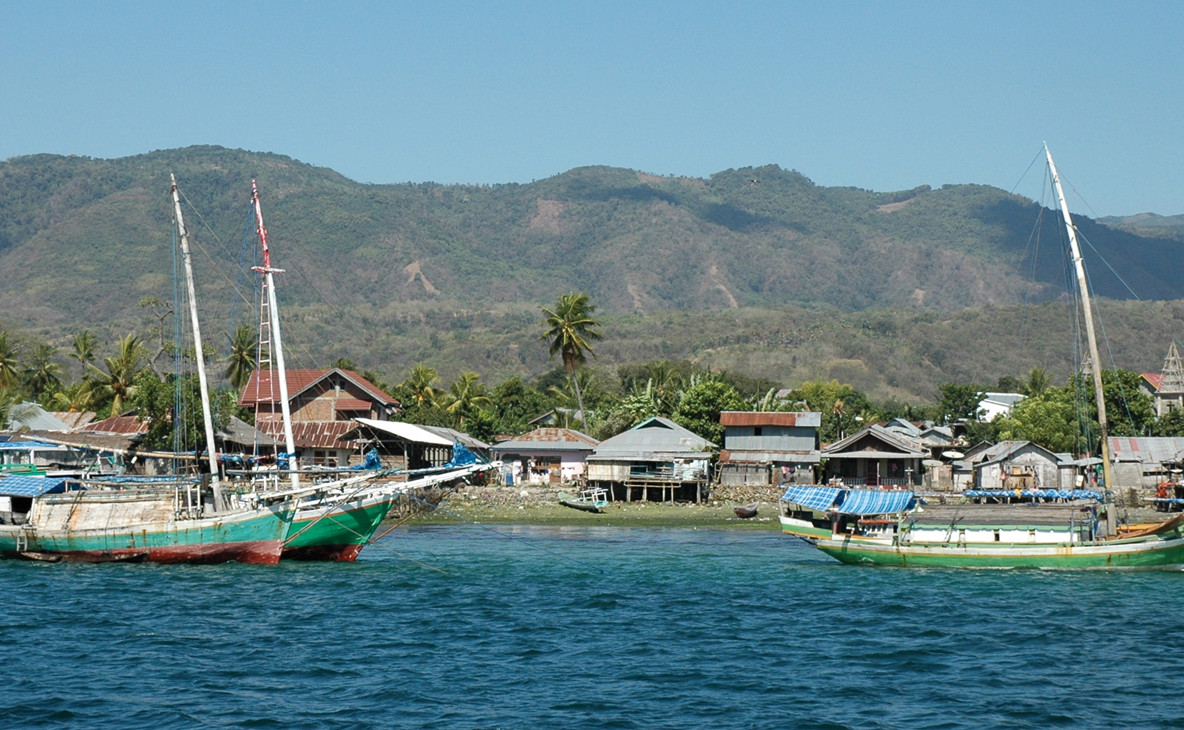
After a night at sea, sailing north, day broke over the south coast of the island of Lembata, to the east of Flores. We approached the small haven of Lamalera, a surprising whaling village, where the sperm whales and pilot whales are still hunted, from May to October. With simple bamboo harpoons, equipped with an iron point, from wooden whalers around ten meters long, propelled by oars and equipped with an auxiliary sail. Catches are limited to around twenty per year, and taking into account the traditional means used, the village escapes the ban relating to this form of fishing, decreed by the International Whaling Commission. In Lamalera, the whole village is involved with whale fishing, and has been since the 15th century. The south coast of the Sunda Islands is on the migratory route of the whales travelling from the Indian Ocean to the Pacific, at that time of the year. An age-old fishing technique is still used in Lamalera; when a whaler has been able to approach an animal to within harpoon range, the harpooner chooses the best moment to take a run up, at the front of the boat, and jump, with the harpoon in his hand, onto the animal’s back, so as to plunge the iron point as deep as possible into the flesh… When the catch is sizeable, it is shared between all the families in the village. Part of the whale meat is dried to be stored, and it is this form that the villagers of Lamalera use to obtain fruit and vegetables from the neighboring villages in the island’s interior, through a barter system which is also several centuries old.
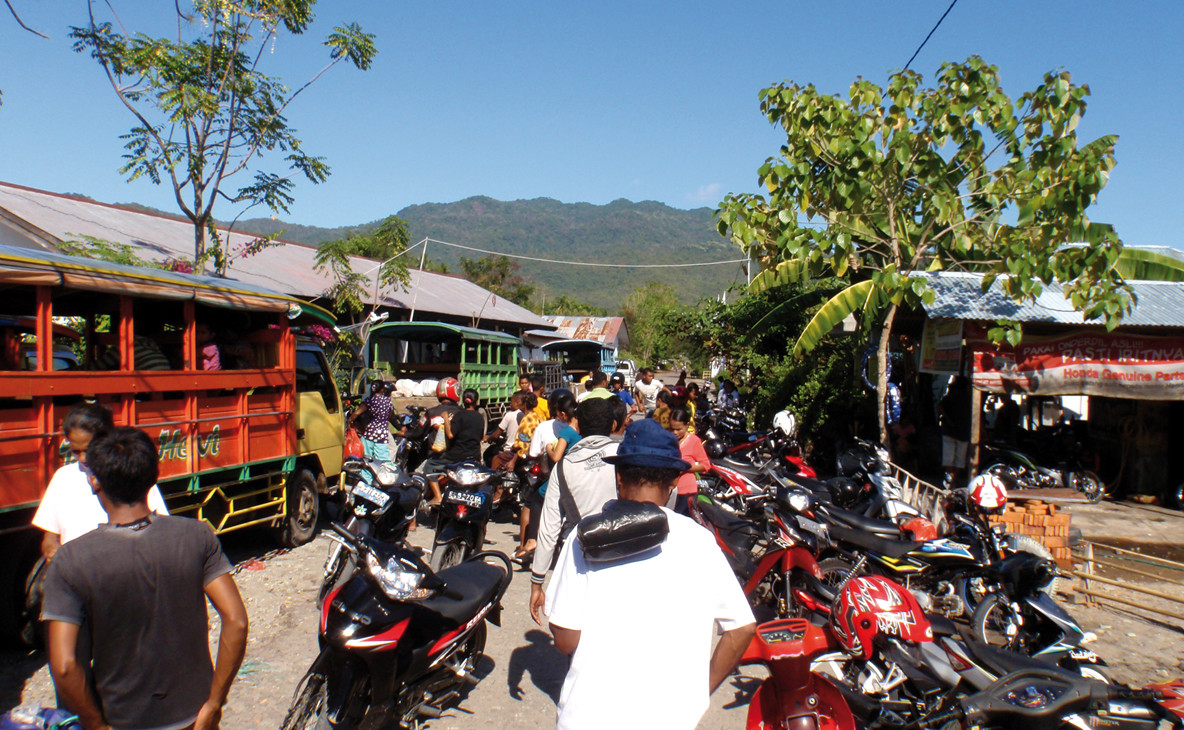
But over the past few years, worry has started to appear in the village. Modification of the migratory routes of the big animals, or more certainly climate change and the harmful consequences of the illegal industrial fishing (Taiwanese and Japanese mainly), the fact remains that sperm whales are becoming rarer on the south coast of Lembata. For the last whaling village in Indonesia, it’s survival…
In the early morning mist, we caught sight of the little black sand and pebble creek at the foot of a high rocky cliff covered in dense vegetation. We could have been in the Azores…especially as the island of Flores was not far away! Along the beach, around twenty shelters with palm leaf roofs covered boats, oars, harpoons, nets and whale remains. With the sails furled, we approached gently. I hoped we would be able to anchor for a few hours in front of the beach, but the backwash was too strong and made this idea too dangerous. Impossible, even. We were on the windward coast, exposed to the prevailing south-easterly wind at this time of year. We had to give up. We entered the selat (straits between the Indonesian islands) Boleng, which leads to Lewoleba, a fishing village at the foot of the volcano, Ili Api, from which a few fumaroles were escaping. We discovered the sometimes impressive strength of the currents in the selats, forcing us to hug the reefs, to take advantage of the counter-currents. Lewoleba bay is criss-crossed by fishing and transport boats of all kinds, often using single-cylinder motor propulsion with a flywheel and an open exhaust – great, but…noisy. We anchored about a hundred meters off the shore, on which dozens of wooden houses on stilts huddled together. Almost-naked children ran about on the dark sand the tide was uncovering. Strong smells of fish mixed with other, more dubious odors, recalling more those of the sewers, which all invariably return to the sea. At the same time as a whole load of waste.
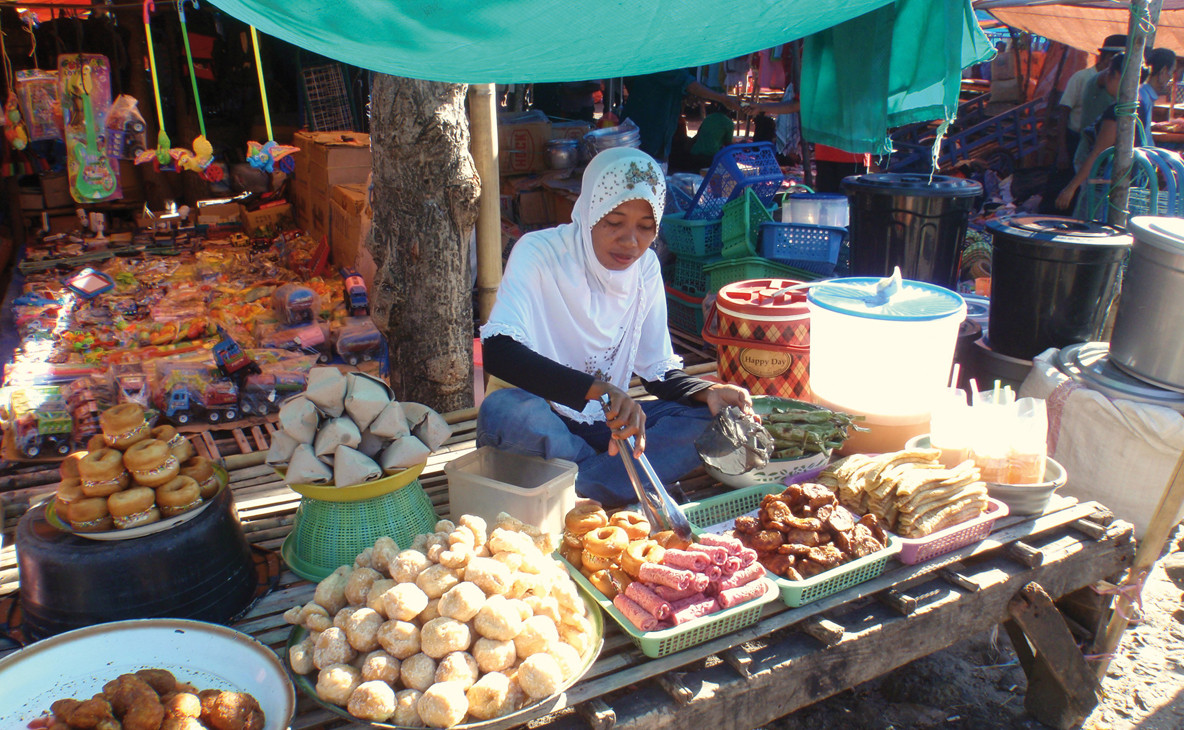
Welcome to Indonesia, deepest Indonesia, varied and brightly colored, odorous and intense. A country, a population, rites and images which, over the weeks, proved to be captivating and finally made for a very nice stopover for the crew of Jangada on our route in the south of Asia. We greeted with a wave the fishermen who passed close to us; they all replied with a reassuring smile. We were of course the only sailing boat in the area, and the only foreigners, but the presence of our catamaran amongst all these working boats didn’t seem to pose a problem. Without a doubt (and it’s often the case), the local sailors have instinctively a certain respect for sailors like us, who have come a long way by sea, and who they guess have sometimes come from the other side of the planet. We landed at the foot of the fishermen’s houses, watched by mothers and a host of children. We slipped between two huts, to reach the village’s main street. We were going to lunch on our first nasi goreng, mie goreng and gado-gado in the bamboo warong (little local restaurant), Pak Tanto’s Makan Berkat Lomblen. Washed down, as far as I was concerned, by a well-chilled Bintang (the large model preferably, the real thing - the standard model is reserved for tourists in Bali). We didn’t linger too long in Lewoleba, the water there was too dirty and my wish to dive and clean the hulls was stopped short by the vision of a respectably-sized sea snake going about its usual and essentially alimentary occupation, along the interior waterline of the port hull…!
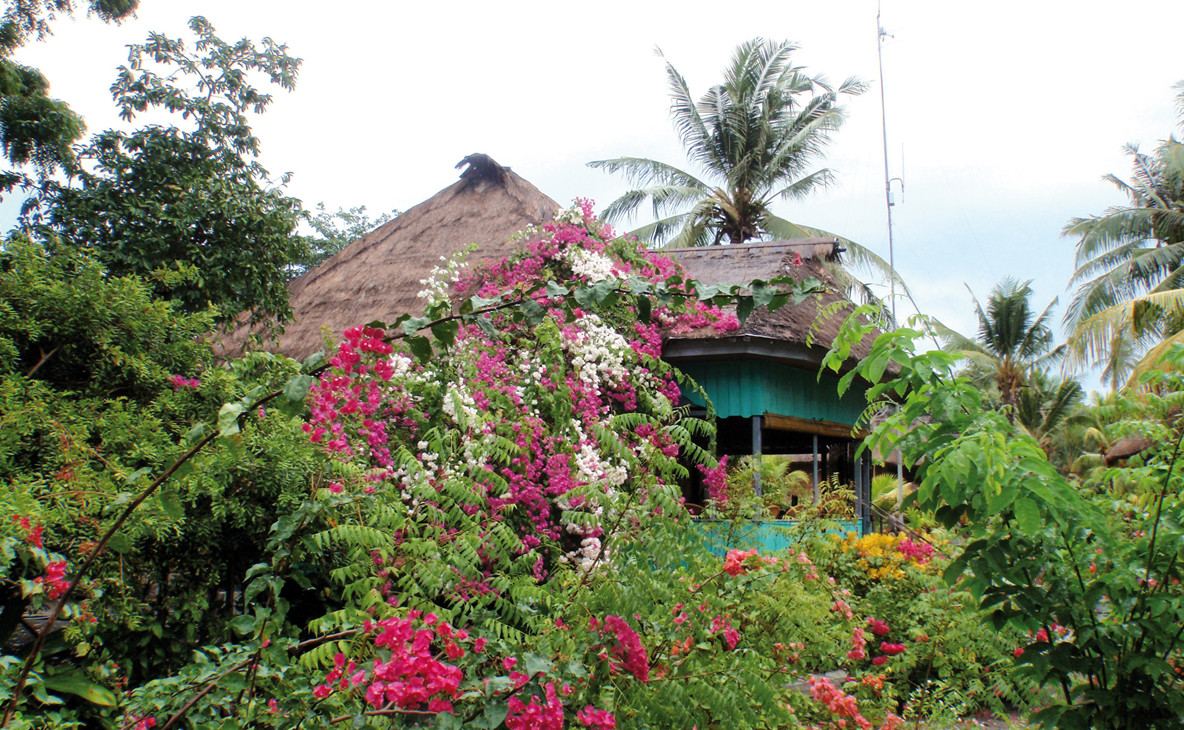
We set off towards the north of the selat Boleng, under full sail, but were soon to discover that close to the islands, the breezes are for the most part changeable in strength and direction, over a few hundred meters. To extricate ourselves from the straits, the two Volvos were welcome. I had the feeling that the main current flowed southwards in the selat at that time of the year. We had to hug the coral reefs to within a few meters to make progress, and finally sail a clearing tack in the full current to succeed in hauling ourselves onto the north coast. Two hours’ effort later, we were able to bear away, and were then on the north side of the Sunda Islands, protected from the ocean’s waves and the prevailing winds. It looked like we were going to have easy sailing for the next few days, with no swell, and most of the time with sea breezes of less than 15 knots - and therefore…quite a few hours under engine!
Technically, for the crew, this meant electrical energy, and an abundance of fresh, cold water. We had had fine weather, sunshine and blue skies on our voyage from the Torres Straits, and our coastal sailing in the Sunda archipelago, short legs of a few dozen miles, proved to be very pleasant. The only little drawbacks to this region: very little nautical information available, fairly inaccurate charts, with dangers on the surface sometimes not marked, deep water often close to the coast, which doesn’t make anchoring easy, and strong currents in the middle of the selat. And of course there are quite a lot of boats of all kinds on the water at night, with very few lights; the IMO’s international regulations don’t seem to have reached certain remote parts of the Indonesian archipelago. But finally nothing too bad, and therefore a real holiday for the Captain!
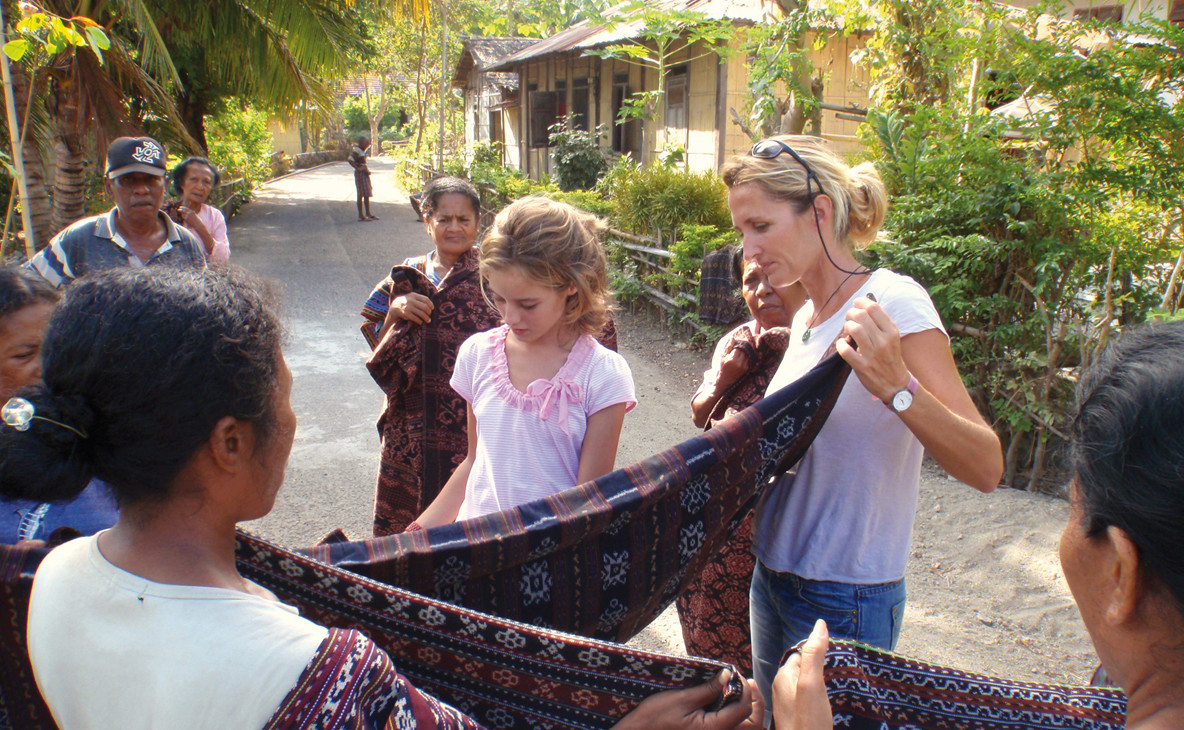
We rounded the eastern headland of the island of Flores at night, and set a course slightly to the east of the bay at Maumere, the island’s capital, on the north coast. Jangada’s powerful masthead flashing light, the only one lit in the darkness, did wonders; as it suggested a fast or a military boat, it tended to make the fishing boats move away from us rather than encouraging them to approach us. In the early morning we slipped between a few small islands and came close to the coast. The inaccuracy of the chart made me suddenly throw both engines into reverse, to avoid running onto a reef just above the surface of the water, which the mirror-like surface and unfavorable light had hidden from us! Damn, that was close. Fortunately I had got into the habit of very regularly looking at the echo sounder…
I had read somewhere that around ten kilometers to the east of Maumere there was a little hotel on the edge of the beach, where we could anchor in complete safety in front of it, to go and visit the main town of Flores and the interior of the island. It bears the slightly ambitious name of the Sea World Club, and we finally found it, hidden under the palm trees. We dropped anchor in around thirty meters of water in front of the straw hut bungalows, surrounded by superb bougainvillaea. The Sea World Club is a modest hotel establishment which includes a small diving club, a beach bar and reasonably-priced internet access, in addition to an anchorage whose safety was guaranteed by the presence of the local hotel personnel: exactly what we were looking for, as we wanted to leave our boat at anchor to explore the interior of the island. We piled into a bemo to get to Maumere. The town is not particularly attractive, but we went to the harbor to watch the local schooners unload. The derrick cables squealed in their pulleys, the dark-skinned dockers operated the guys, diesel-powered winches filled the air with decibels, the sacks of rice piled up in the holds, destination Java or Sumatra. It reminded me of my first profession as a Merchant Navy officer, which I liked! We had lunch in a warong at the harbor, next to dockers and customs officers in uniform. We found the pasar, the fruit, vegetable, meat and fish market – particularly odorous but well-stocked. I freely confess that it’s one of my favorite activities when cruising - strolling round the local markets. This allows me to quickly get an idea of the local standard of living, the richness of the country, and to feel the spirit of a community. In a few minutes, you can learn a lot of things. I love it.
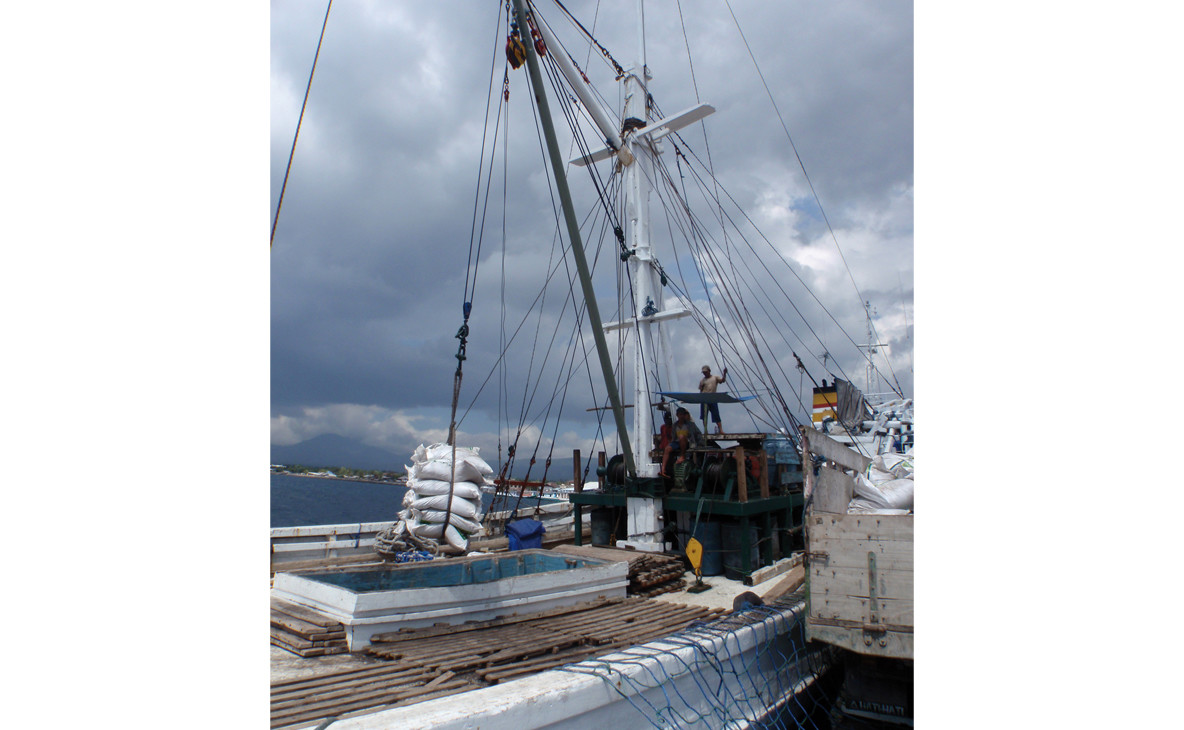
On returning to Sea World, we booked a Toyota with a driver for the next day, departure at 5 am, Heading for the Kelimutu volcano, three and a half hours by road from the anchorage.
Flores is a mountainous island, with rugged hills covered in tropical vegetation, 375 kilometers long and 12 to 70 wide. There are a dozen active volcanoes on Flores. The Portuguese presence has left its mark, especially on a religious level: 85% of Flores’ inhabitants are Catholic, but animist rituals are still very present in the remote mountain villages. Agriculture and fishing are the two pillars of the local economy; tourism is still not very developed here, except at the extreme west of the island, around Labuan Bajo.
Very early morning for the crew of Jangada. Quick breakfast. We pulled the dinghy up the beach thanks to its system of built-in rollers, and climbed into the Toyota. Direction – the little winding mountain roads. We crossed rice fields, and then, as our altitude increased, the tropical forest took over. The Kelimutu is a volcano which nowadays is not very active, but it has a complicated history. Three lakes in the crater, with different and changing colored waters, have made its reputation. Rising to an altitude of 1,639 meters in the center of Flores, the Kelimutu is a sacred volcano for the Indonesians. The black lake, cut off from the other two, is the one dedicated to old people. The green lake (sometimes emerald green, sometimes turquoise), with acidic waters, is that of the young people. And the third, separated from the previous by a simple rocky rampart, is ordinarily reddish-brown in color, sometimes brown. This is the enchanted lake. The view from the summit of Kelimutu over the three lakes in the crater with their exceptionally dense colors was magical, but an hour later, the clouds surged around the neighboring peaks. It had been worth getting up early! We passed via the village of Moni again, nestled on the slopes of the volcano, in the middle of the rice fields, then drove back down towards the south coast via the little winding road which heads east.
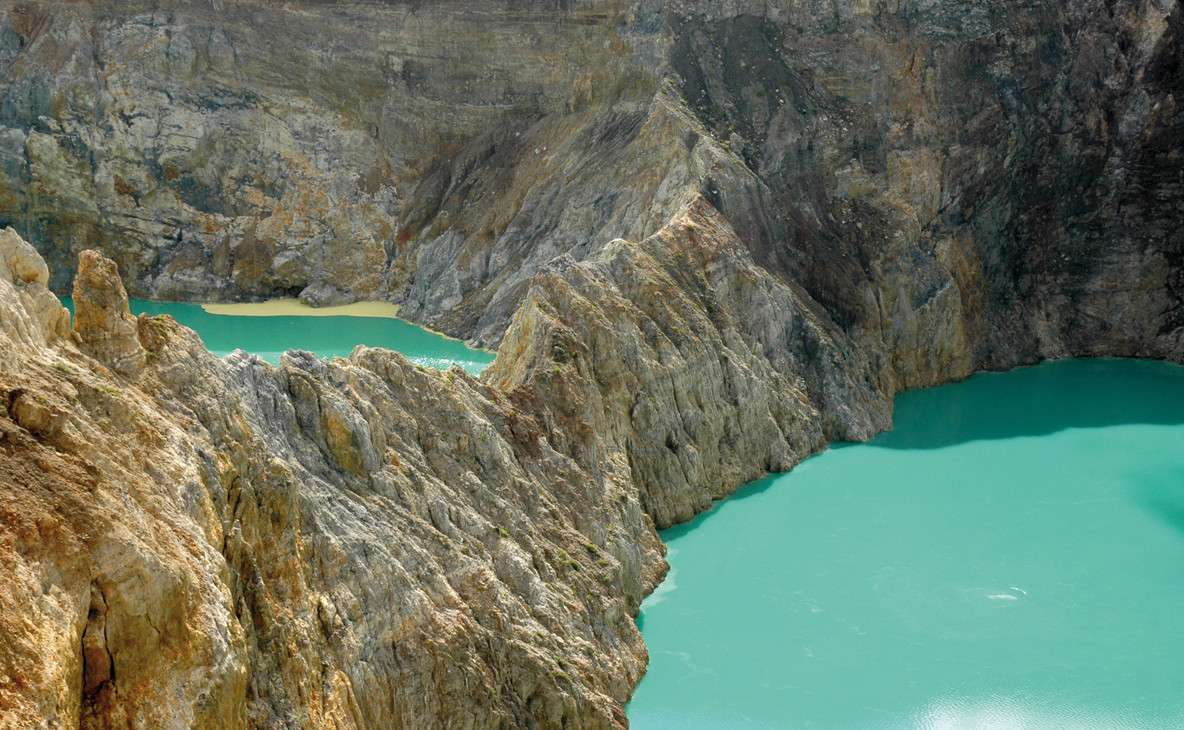
We reached the coastal village of Sikka, one of the first colonies established by the Portuguese on Flores. A fishing village with wooden houses built on the black rocks and the dark sand of the shore. At Sikka, there is not a single woman who, in addition to her daily housework, is not weaving an ikat in a corner of her house or garden. When we arrived, they recognized our driver, whose parents lived in the village.
One by one, they came out of their homes, with their ikat in their hand, to try and sell it to us. Soon there were about ten of them, then twenty, and finally around fifty of them surrounded us! Barbara and Adélie observed the splendid ikats which were pirouetting around us. After a little hesitation, they discretely agreed on a deep blue ikat, at my request. I then asked them to move away, to make my job easier. It was up to me to negotiate! I had asked our driver, and I knew how far I could try to go. I informed the happy beneficiary, and asked for her price, 500,000 rupees, immediately made her a deliberately low offer of 300,000, but with a smile and a few complimentary words about her beautiful work. Looking disappointed, as well as disinterested, I turned on my heels and went to join my clan, who were visiting the village. When we returned, the same crowd formed again, I negotiated upwards with the chosen woman, and finally paid 380,000 rupees. Around 35 euros. So now we had a beautiful ikat from Flores! We returned to the Sea World Club late in the afternoon, on the north coast, where the ikats were being sold at…three times the price. Jangada was waiting calmly in the anchorage, in front of the bamboo hut of the little beach bar. The next day, we were going to head west.
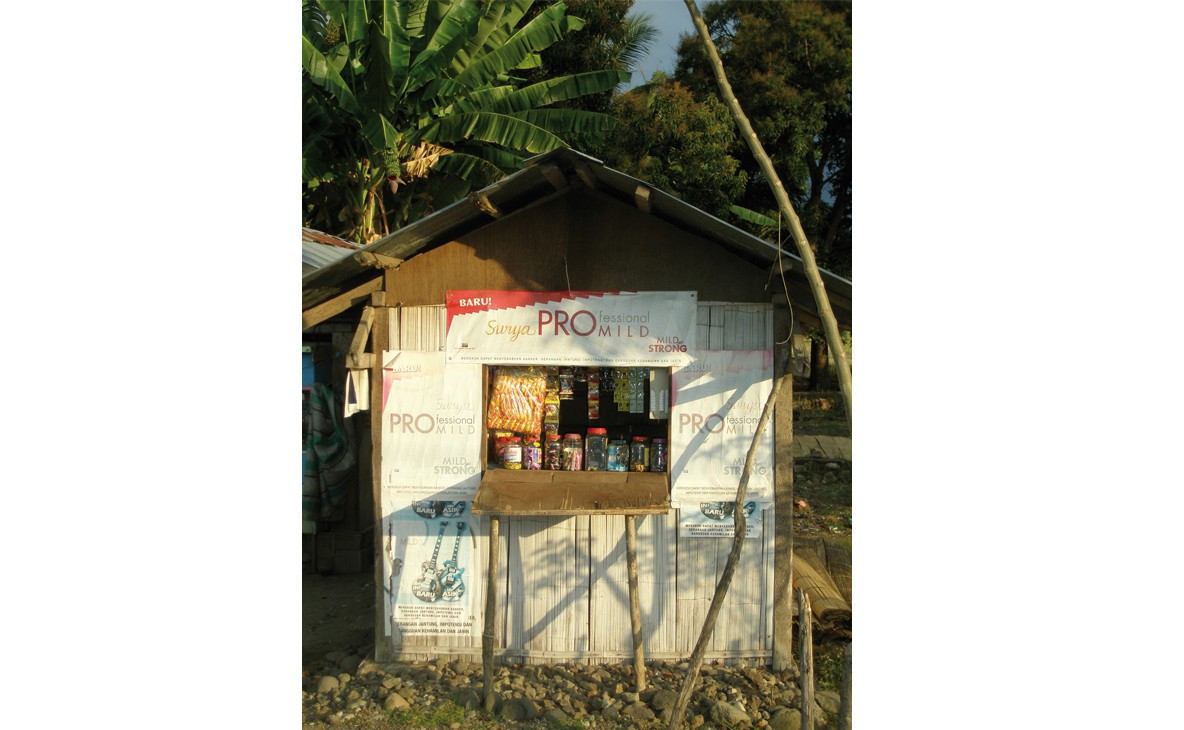
What readers think
Post a comment
No comments to show.